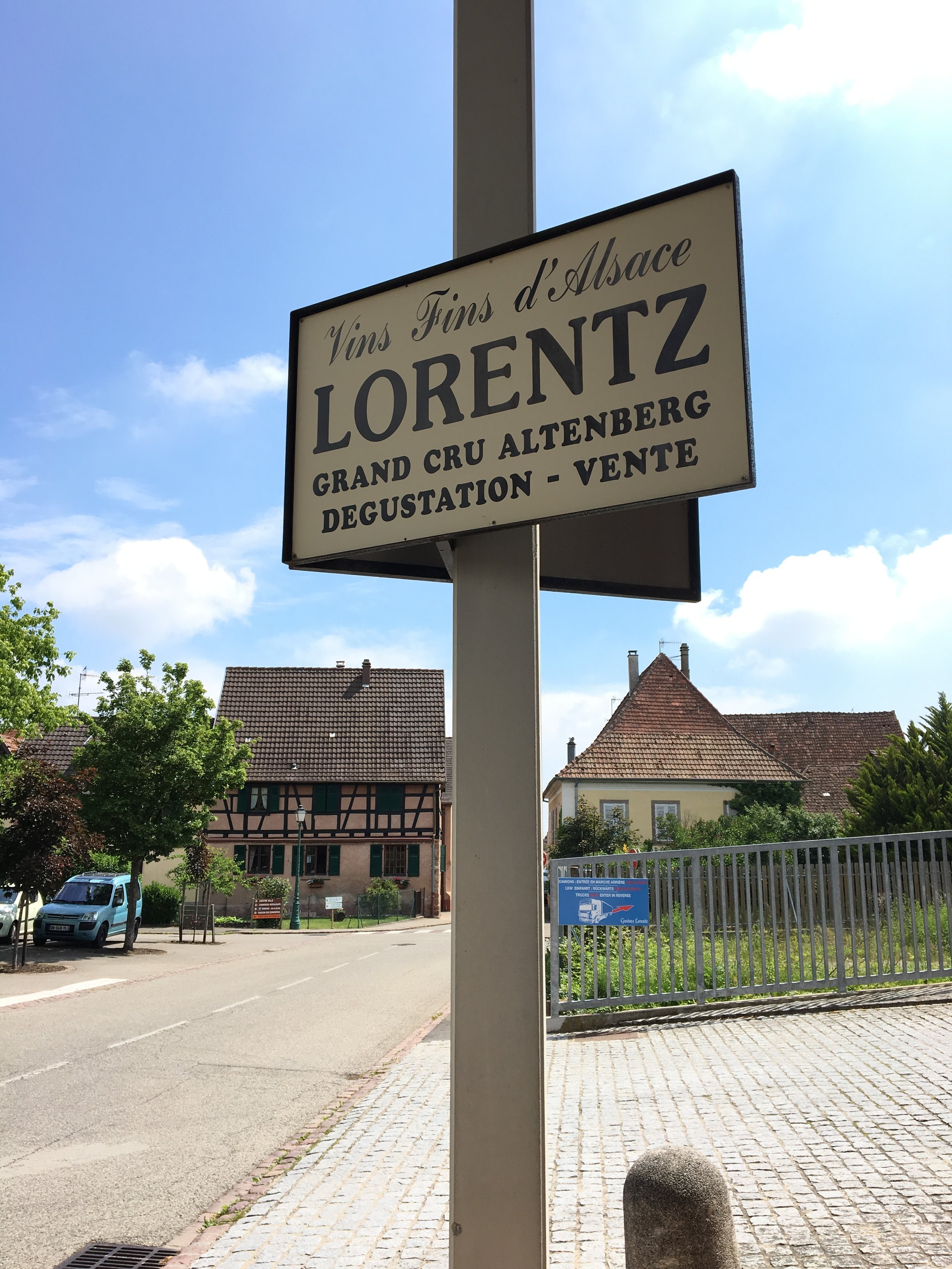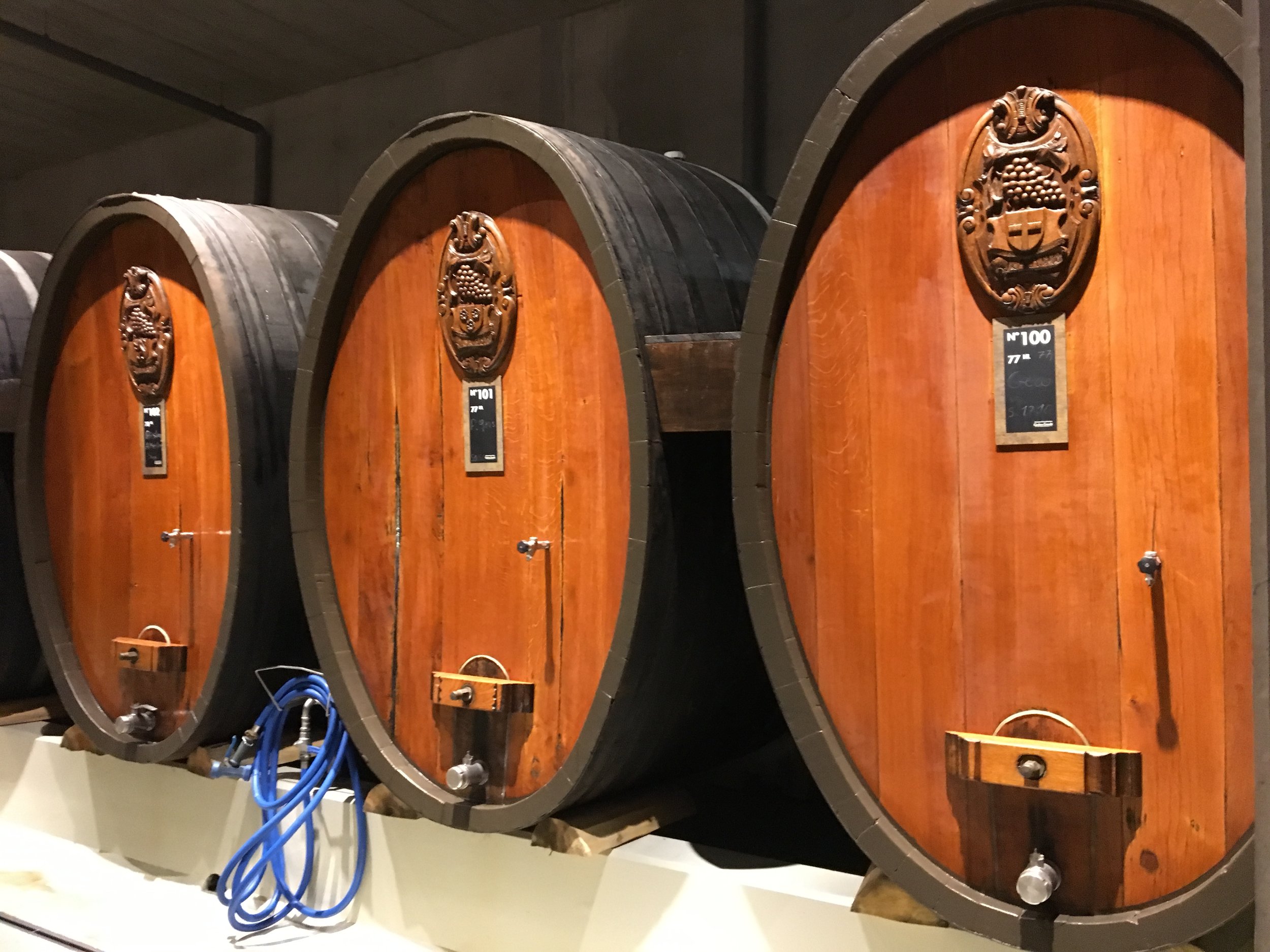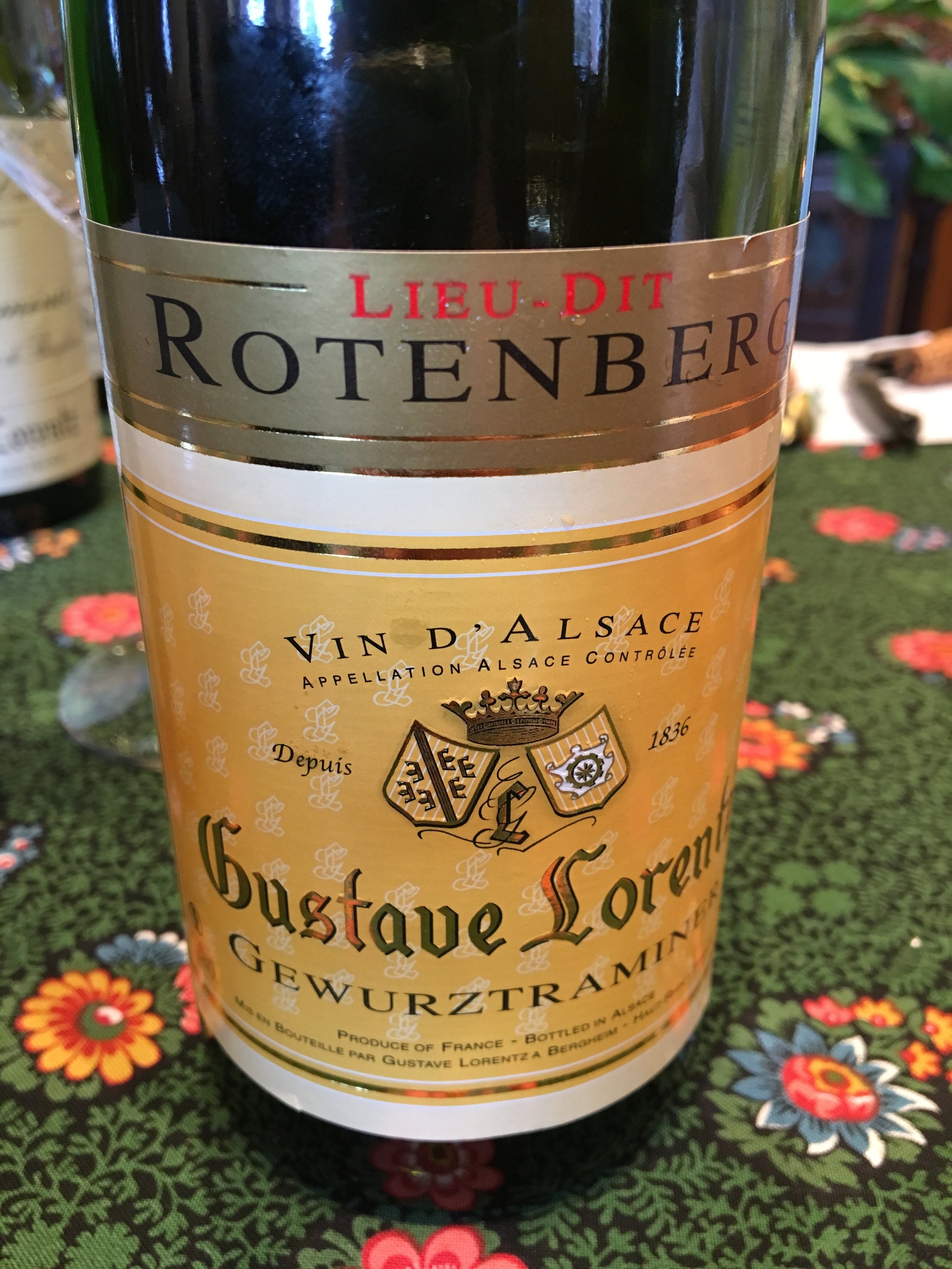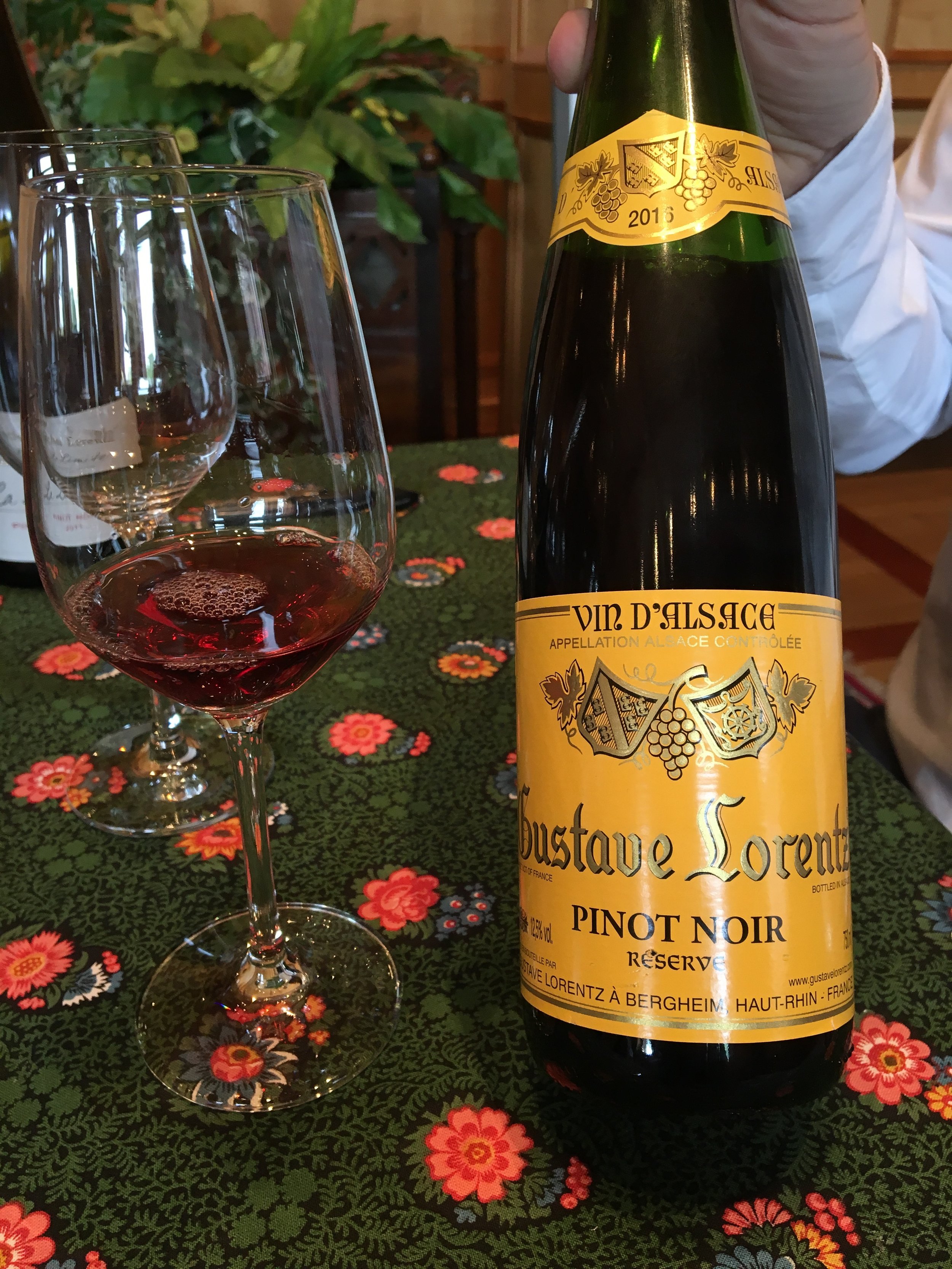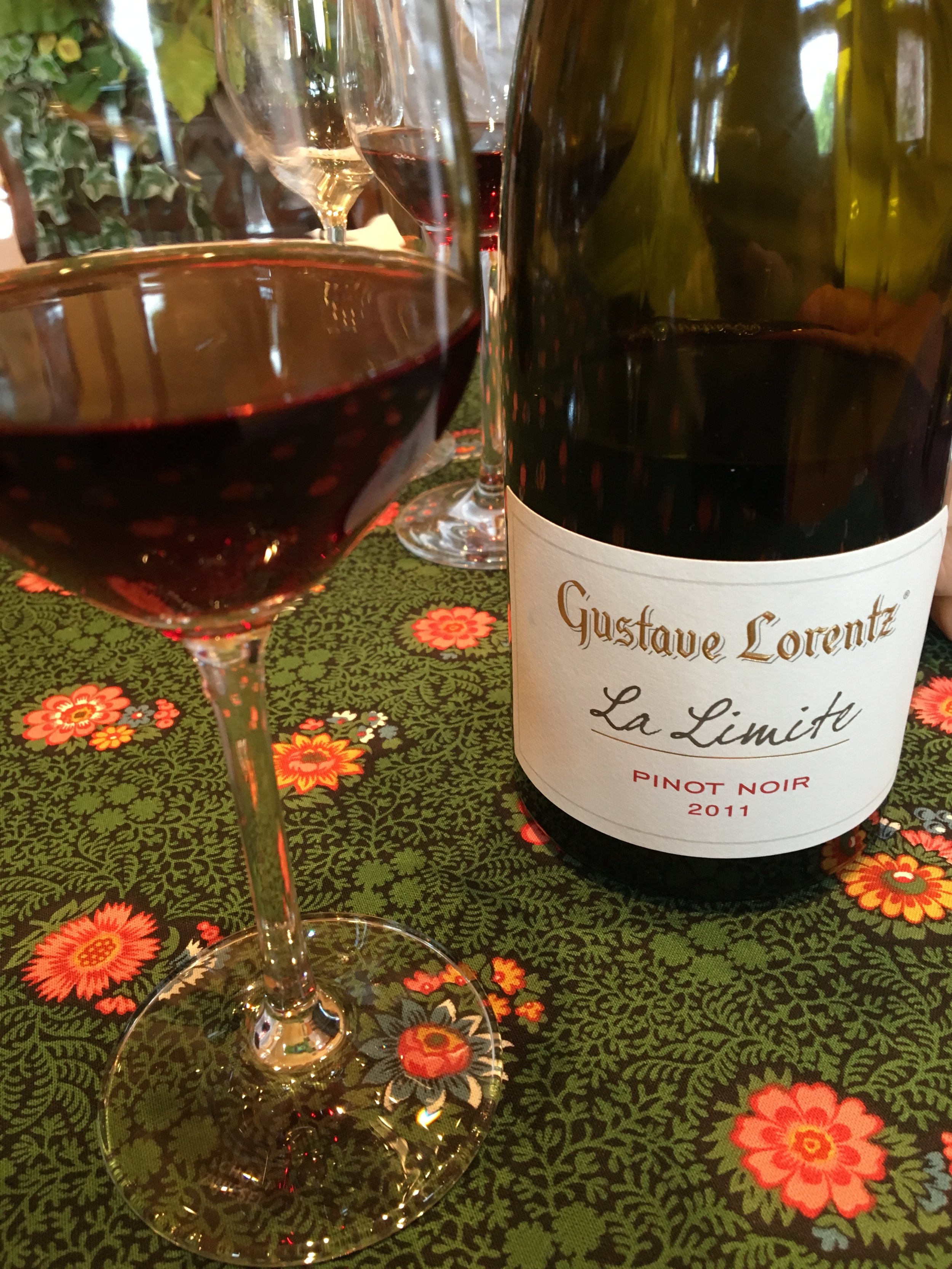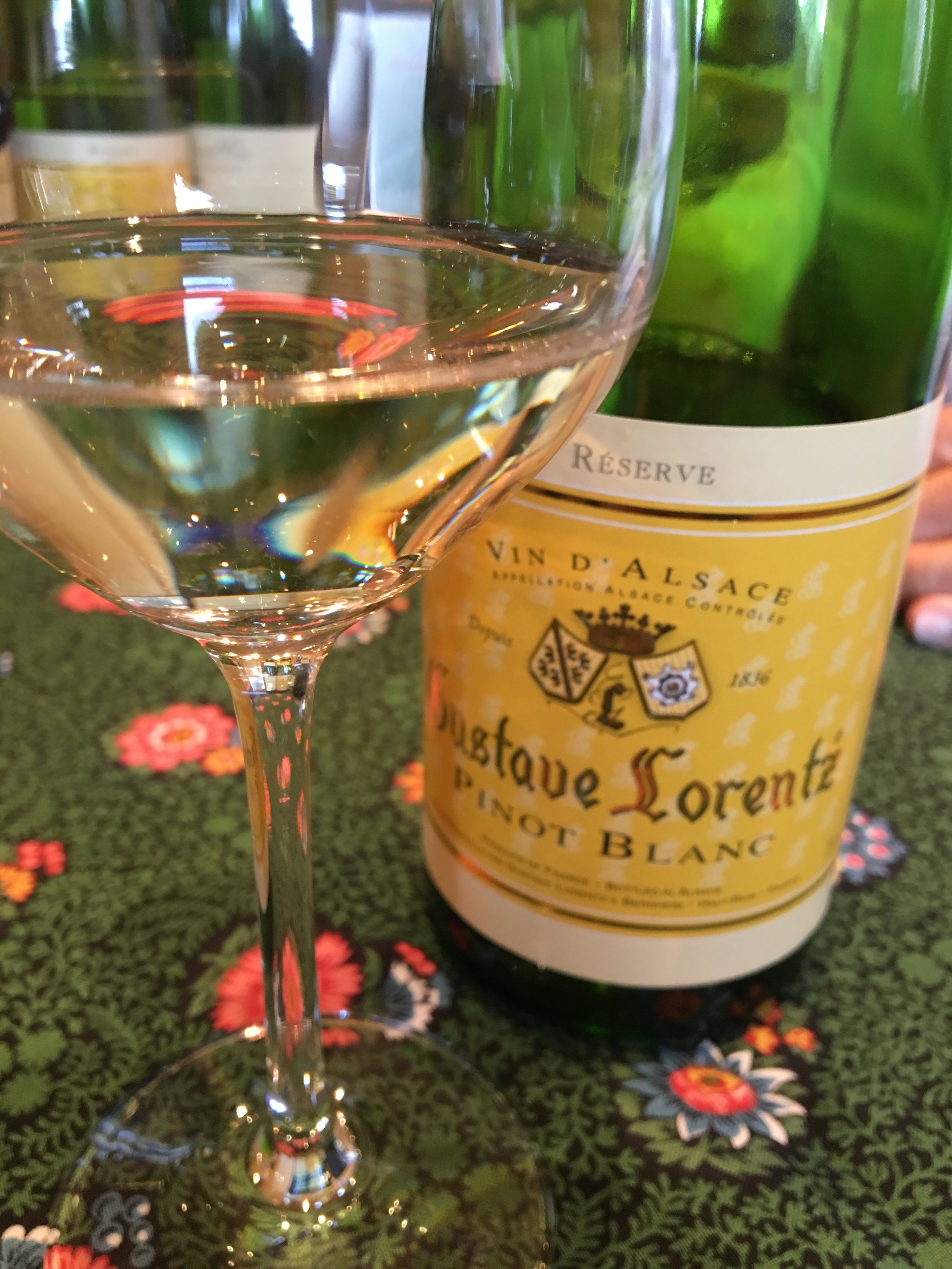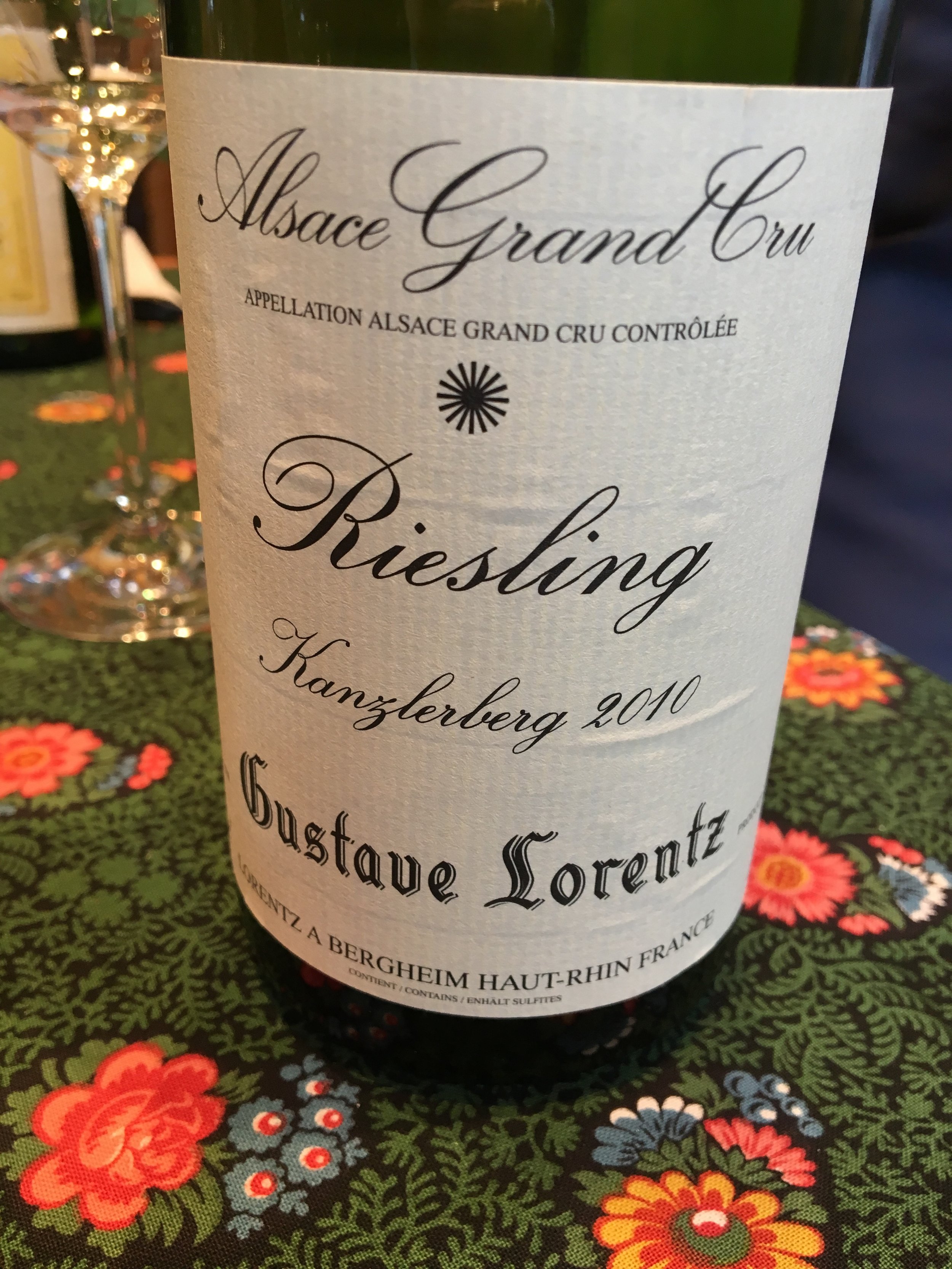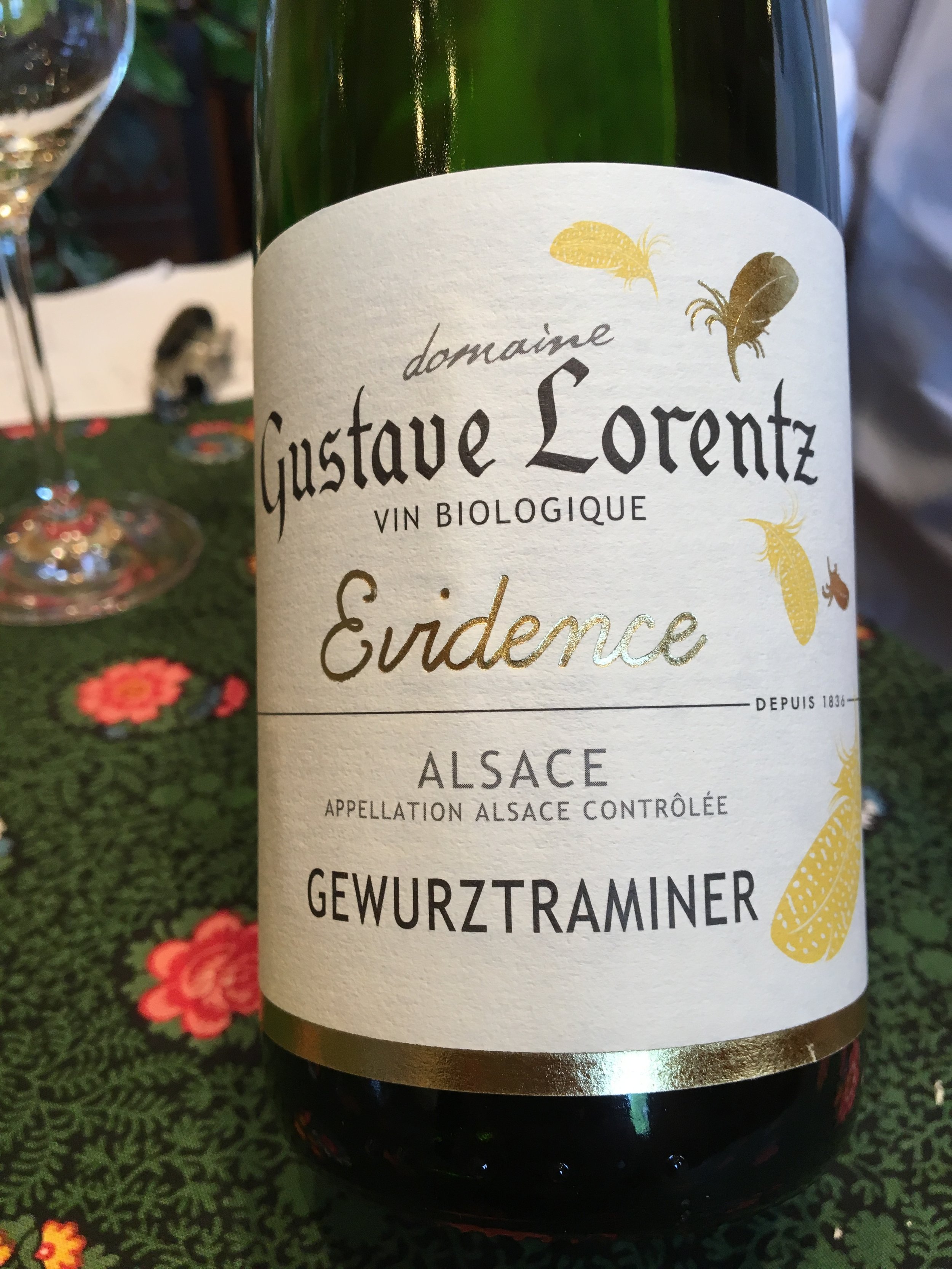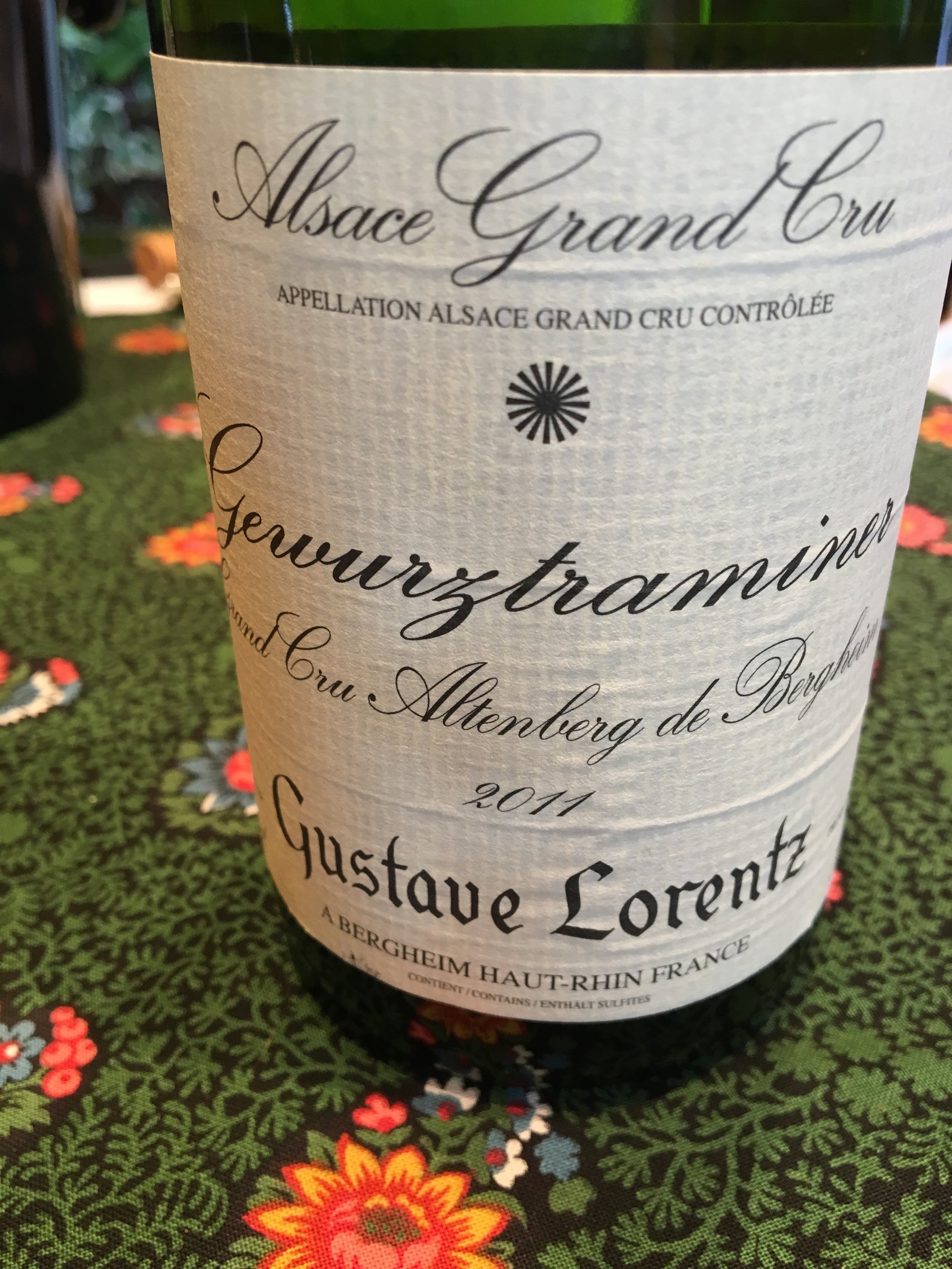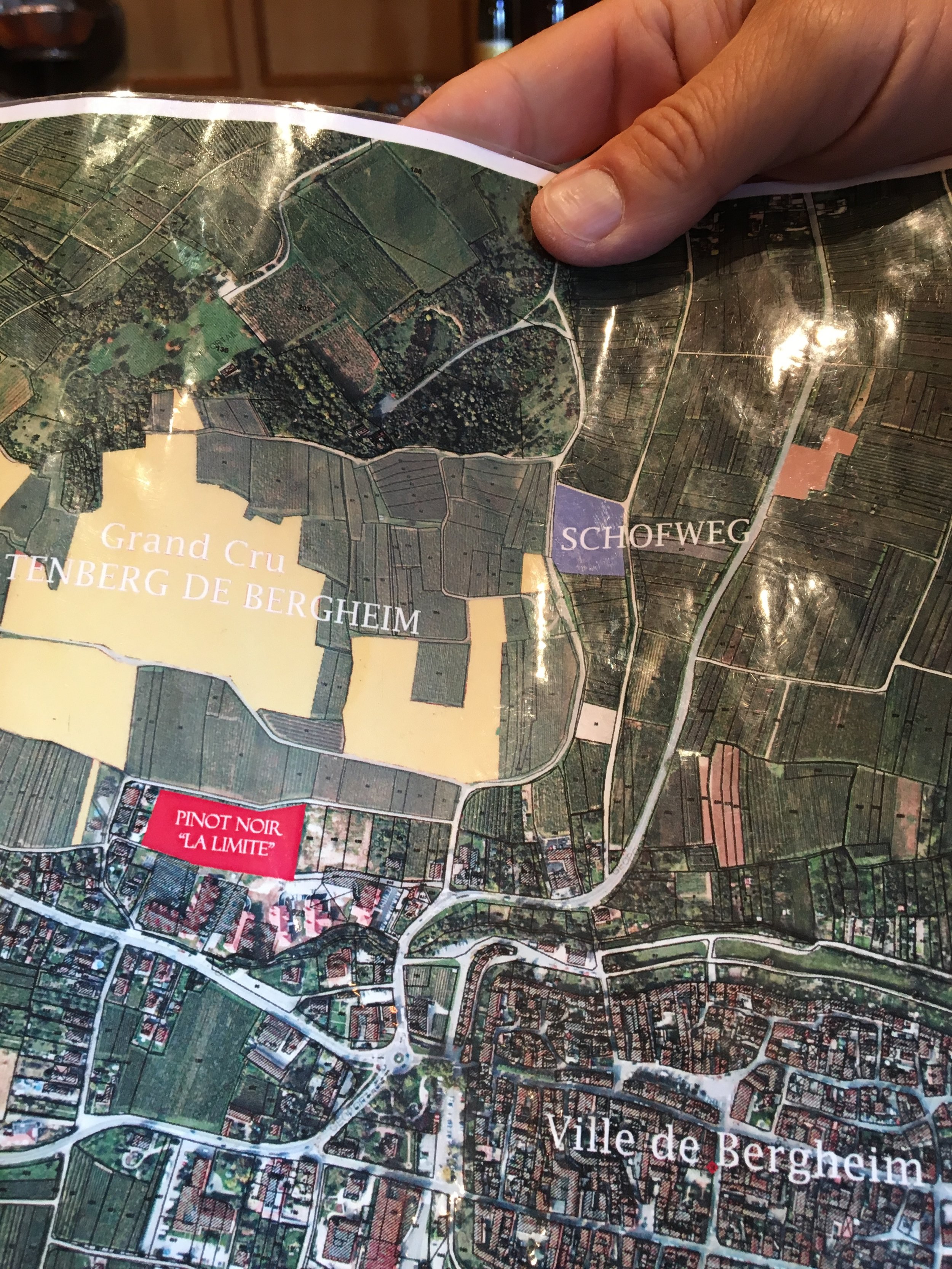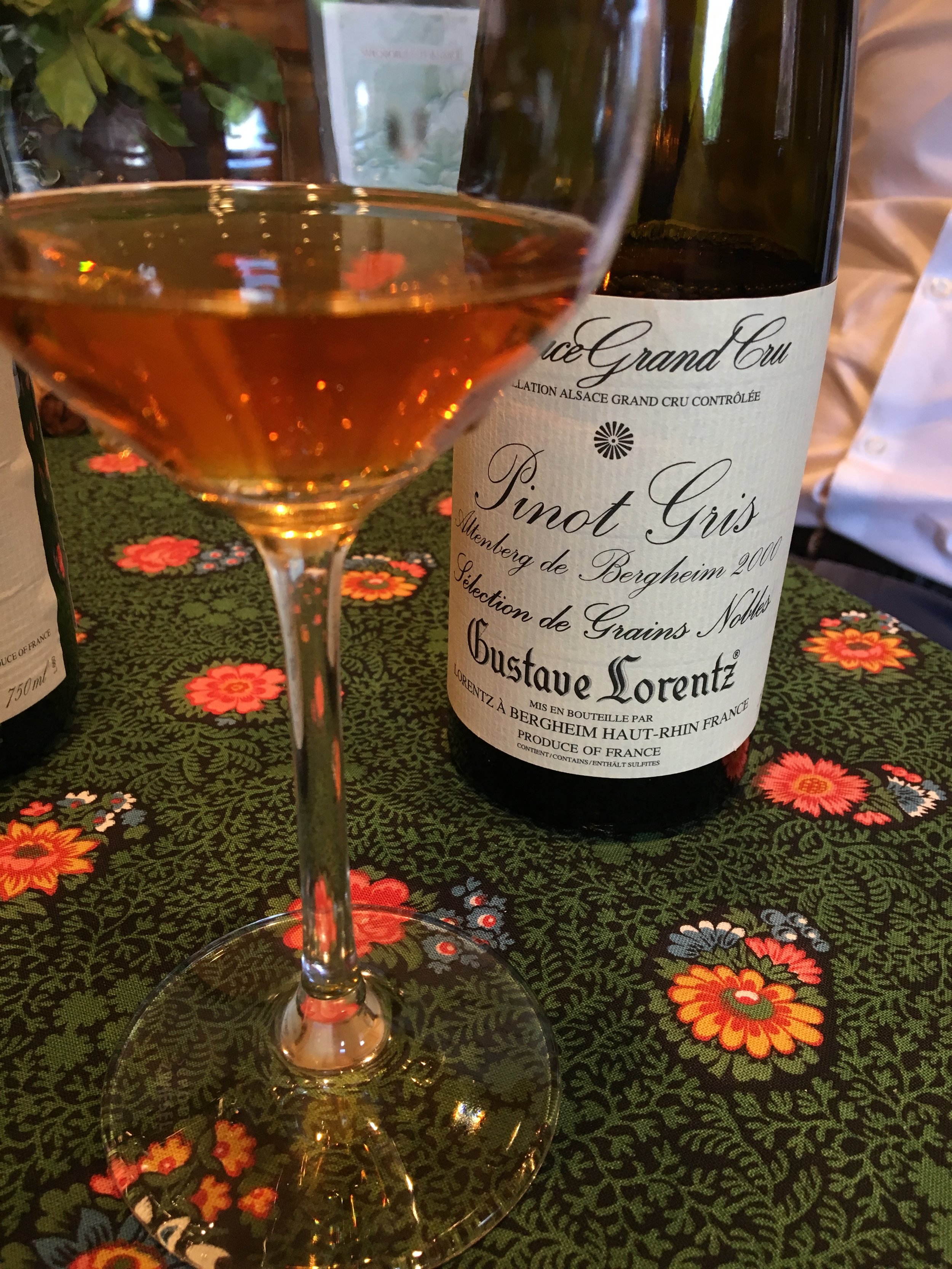Gustave Lorentz creates distinct Alsatian wines with freshness, complexity
Georges Lorentz points out Grand Cru Alsace vineyards from the roof of Gustave Lorentz winery.
Visiting the land of Alsatian Wines at Gustave Lorentz
I recently had the good fortune to visit Gustave Lorentz winery in the pastel-colored village of Bergheim, in Alsace, France. This bucolic land of verdant hillsides and rustic villages borders the Rhine river, which separates northeastern France from Germany. It's that cross-cultural aspect that makes the place unique, and some of the language sounds more German than French due to both proximity and history. Today its delicious regional cuisine includes Tarte Flambée, pungent Munster cheese, and crisp cider. But, it was Alsace's distinct wines that drew me for a visit.
A historic wine-making family and region
The Gustave Lorentz family has made wine in the region since 1836. The current owner and president of the winery, Georges Lorentz, hosted me there. It was his grandfather, Charles Lorentz, Sr., whose passion for wine making spurred him to plant vineyards on the slopes of the Altenberg hill, in the foothills of the Vosges mountains. Today Altenberg de Bergheim is one of the largest Grand Cru vineyards in the northern Haut-Rhin.
Alsace wine tasting at Gustave Lorentz
Gustave Lorentz has occupied several locations in the pretty village of Bergheim, but recently moved to a larger space, and now boasts striking, modern offices in addition to a sleek winery. The new space hosts wine tastings in French and English that can be booked here.
Art installation on roof of Gustave Lorentz winery in Alsace
On the roof of the winery is a pretty landscape art installation, and from there, Georges showed me the Grand Cru vineyards that he nurtures for his top wines. On the top of a hill facing us was the prestigious vineyard Altenberg. Georges pointed to me to a few more, until we had made a 360 degree visual tour of the hills surrounding his winery. My curiosity piqued, he then led me inside to the gracious tasting room filled with antique furniture and vinous knick knacks from a bygone day.
Historical wine arts and crafts decorate the tasting room
Tasting of current Gustave Lorentz wines
Crémant D’Alsace
Georges starting me with sparkling. I am a huge fan of French crémants, which offer different grape varieties and flavor profiles than Champagne, and at a significantly lower cost.
Gustave Lorentz rosé brut
Crémant D’Alsace Brut – This sparkling wine made in the traditional method offered freshness, acidity, crisp citrus support by a note of biscuit from its lees aging.
Crémant D’Alsace Brut Rosé – Another traditional-made sparkler from Pinot Noir, this wine offered fresh red fruits, finesse, and a good finish. A beautiful, pale rose color and persistent, small bubbles makes this a perfect hostess gift or celebratory wine.
Fresh Pinot Noir from Alsace
We then moved on to some of the Pinot Noirs from the area, and these were universally light, fruit-forward, and balanced.
Pinot Noir Réserve 2016 – A cool climate rendition of Pinot Noir, with a translucent ruby color and tart red fruit character. Georges told me it is designed to be fresh, elegant and drunk young with fruit at the fore, in the spirit of Alsace winemaking. Cool maceration and fermentation temps retain that freshness he’s after.
La Limite Pinot Noir 2011 – This pinot noir was grown in a vineyard at the foot of the Grand Cru Altenburg vineyard, therefore the name “the limit.” The 2011 was just released in 2017 – a testament to the winery’s commitment to build character in the wine through cellaring. The wine spent a year and a half in barrique and then another rested in bottle until release. The palate offered dried herbs, desiccated cherries, bright acidity, and a long finish.
Pinot Noir Le Rosé – From 100% Pinot Noir, this rosé had a fresh strawberry nose, crisp acidity, strawberry and cloves on the palate. Definitely a bigger rosé than many with good structure. I consider this an excellent wine for food – delicious.
White wines from Alsace
Then, we moved on to the famous Alsace white wines. Georges provided me with a rare opportunity to taste through most of the current releases, which was an amazing, on-the-spot education on the broad range of flavors available from the white grapes here.
Crisp Alsace Pinot Blanc
Pinot Blanc Evidence 2015 – Quaffable, crisp white with high acidity, tart lime, minerality, and slightly oily texture.
Pinot Blanc Réserve 2016 – Lovely and affordable, this is the kind of wine that makes Alsace such a great value. Nose and palate of fresh pear, crisp and light.
Rich Alsace Rieslings
Riesling Réserve 2017 – White flower nose. Medium-intense tropical fruit, plus pear, peach and a spritz of crisp citrus. Spot-on Alsace Riesling.
Lieu Dit Burg Riesling - “Lieu Dit” translates roughly to “locality” but in this case, meaning a wine that shows characteristics of a particular place - in this case, Burg. Lovely floral nose with hint of diesel, rich tropical fruits, somewhat oily texture. Nose fresh and intense.
Alsace Grand Cru Riesling Kanzlerberg 2010 – This wine is sourced from the smallest Grand Cru vineyard, a cooler spot than the Altenberg vineyard, with marl and gypsum in the soil. The nose offered dense tropical fruits including lychee, pineapple. The palate was like peaches and butterscotch. The finish was long. Georges says to serve this with sashimi. I gave it four stars.
Alsace Grand Cru Altenberg de Bergheim Riesling Vieilles Vignes 2012 – Georges told me this old vines vineyard gets lots of sun and the crevices in the landscape keep warm air on the vines with soild of clay and limestone. All that sunshine and warmth produced a more full-bodied, structured wine than the 2010. There was citron on the nose, and on the palate, lush grapefruit and honeydew. A gorgeous representation of terroir that will age intriguingly.
I left the Rieslings somewhat regretfully, but there was another great Alsace grape to explore: Pinot Gris.
Distinctive Alsace Pinot Gris
Pinot Gris Réserve 2016 – Luscious bosc pear, the fruit was sweet but the wine was dry. A round, yummy wine.
Lieu Dit Schofweg Pinot Gris – Schofweg is old Alsatian for “sheep’s way,” indicating the old shepherd’s path. The vines here face southeast, and are right next to the Altenberg vineyards. This single vineyard wine was richer, sweeter, and the ripe pear mingled with ripe yellow peaches.
Pinot Gris Kanzlerberg 2010 – Each wine in this part of the tasting got richer. In this wine, the fruit veered towards juicy apricot along with ripe bosc pear and quince. When harvested, the grapes have lots of late-harvest drying and boytritus, creating a plush, rich wine of distinction. I gave this wine four stars.
Grand Cru Altenberg de Bergheim Pinot Gris 2011 – Full-on richness now, gorgeous ripe apricot and nectarine lifted by acidity. A complex wine with residual sugar, but still elegant and fresh. Another four star wine for me. Georges recommended serving this with foie gras, game, or old Comté cheese.
Bold Alsace Gewurztraminer
Moving on to the grape known for its intense aromatics – Gewurztraminer. The intensity of this grape can sometimes produce wines that feel almost overwhelming, but I was pleasantly surprised by the elegance of this grape in the hands of the Gustave Lorentz winemakers.
Evidence Gewurztraminer (Vin Biologique) – A dry Gewurztraminer grown with organic methods, and a new project for the winery. This wine had characteristic lychee nose and palate but was also fresh and elegant. Georges recommended serving with spicy Indian or Mexican dishes.
Lieu Dit Rotenberg Gewurztraminer – Georges told me the vineyard has lots of limestone, and I loved that this wine offered dry minerality in addition to the lush tropical fruit. I was impressed with this wine’s elegance.
Grand Cru Altenberg de Bergheim Gewurtztraminer 2011 – A wine of great intensity on nose and palate, it offered uber lush lychees, with aromas of white flowers blooming in a rainforest. Georges recommended this gorgeous, rich wine be served with foie gras, and local cheeses including Muenster and Alsace Blue.
Show-stopping dessert wine from Alsace
Grand Cru Altenberg de Bergheim 2000 Pinot Gris – Sélection de Grains Nobles – A dessert wine of distinct character. This 18 year old wine had developed rich tertiary aromas and flavors including toffee, baked pears, and cinammon. A rare and lovely wine I gave four stars.
My extensive exploration of the Alsatian wines of Gustave Lorentz greatly increased my already considerable admiration for this area. My contention is that Americans should drink a lot more of these wines – even grapes we may feel we know (Pinot Gris is Pinot Grigio) develop so differently in this terroir. The winemaking and vineyard management skill is evident in all the wines of Gustave Lorentz. Seek them out and prepare to taste distinct, fresh, elegant wines.


